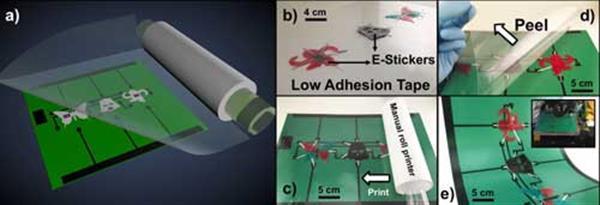Nov 5, 2016 | By Benedict
Researchers at Saudi Arabia’s King Abdullah University of Science and Technology (KAUST) have developed a new method for 3D printing high-performance electronic decals for Internet of Things applications. The method involves printing complex CMOS circuits using advanced nanofabrication techniques.
Stickers can serve many purposes. For kids, filling up a sticker album of sporting heroes can be a rite of passage, while many a lunchbox has been decorated with colorful pieces of gluey paper. For adults, uses for stickers have—thus far—been more limited. Certain decals are used to decorate glass and porcelain, and stickers can be used to promote political parties and such like, but most serve only aesthetic or marketing purposes. It was with some surprise then that we learnt of a new 3D printing system, devised by researchers at KAUST, which uses a silicon-based film to house tiny electronic circuits which can then be stuck onto surfaces for IoT applications. 3D printed electronic stickers? There’s an idea that should stick.
The new printing method combines mature CMOS circuit fabrication processes and recently developed additive manufacturing techniques in order to package fully flexible high-performance electronics for future IoT or Internet-of-Everything (IoE) applications. According to the researchers behind the project, the 3D printed “sticker” electronics could be used like RFID tags are today, but with more functionality and performance.
By using established CMOS technologies like photolithography, deposition, and patterning on a low-cost silicon (100) substrate, the KAUST scientists were able to apply thin, film-based electronics onto silicon, before packaging them using a 3D printer and finally printing the “decal electronics” onto soft substrates. Roll-to-roll printing gives the decal electronics the advantage of allowing high throughput in complex flexible electronics systems, and the circuits have shown no performance degradation after the flexing or packaging processes.
The researchers’ new IoT printing technique essentially makes use of three different printing techniques: 3D printing for the packaging materials, inkjet printing of silver nanoparticle-based inks for the circuits, and a roll-to-roll platform for printing the stickers onto surfaces. The technique shows that devices needn’t be housed in solid cases requiring large packages, but can instead be packaged as flexible and low-cost “stickers” that are able to maintain the characteristics of state-of-the-art electronics.
“The most significant achievement is the development of a new integration strategy to package, interconnect, and print inorganic-based high performance electronics with uncompromised stability and electrical characteristics,” researcher Galo Torres Sevilla told Nanowerk. “This opens up multiple opportunities for applications such as, printed communication devices and flexible high-performance electronics, where current printed electronics are just not able to satisfy the performance requirements.”

According to the researchers behind the project, the 3D printed decal electronics could open up endless possibilities for IoT connectivity, since they can be applied to virtually any surface, hard or soft. Home automation, didactic electronics, and high-volume flexible consumer electronics could all benefit from the new technology, but the researchers have even bigger plans for their three-pronged printing process.
The next step for the research team is to transform all kinds of highly complex circuits into decal electronics, demonstrating that the sticker roll is capable of housing flexible devices of a serious nature. According to Muhammad Mustafa Hussain, an Associate Professor of Electrical Engineering at KAUST, the biggest challenge will be the inclusion of a flexible power source, and the team is currently developing a flexible solid-state battery to play that role.
“We believe that the future of electronic applications is profoundly based on the introduction of new form factors to electronic devices,” Hussain said. “In this present work, we show that inorganic high-performance devices can finally be used for IoT and IoE purposes without the need [for] highly complex and expensive processes.”
The KAUST researchers’ findings have been published in the October 13 edition of Advanced Materials.
Posted in 3D Printing Application
Maybe you also like: